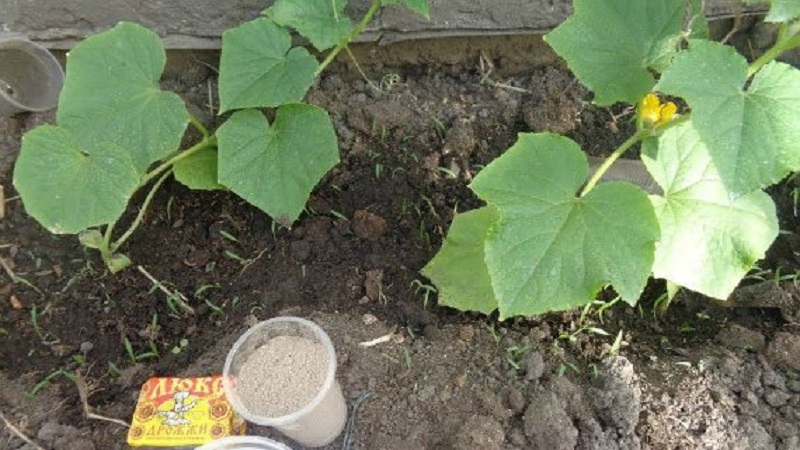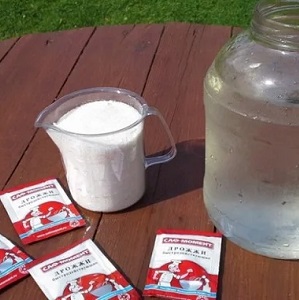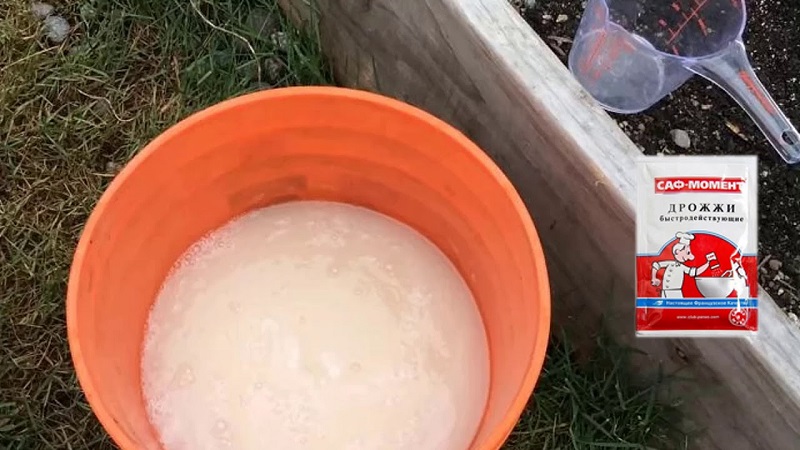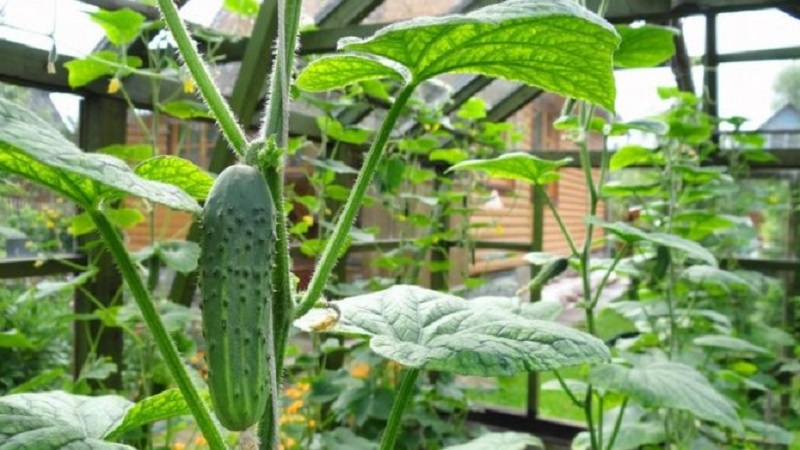What is useful for feeding cucumbers in a greenhouse with yeast, how to cook and use it correctly
Do you want to grow an environmentally friendly harvest of cucumbers? Try yeast - an ideal growth accelerator that will give an impetus to plant development, strengthen the root system, and ward off diseases.
We will tell you how to fertilize the soil with yeast so as not to harm the vegetables, what are the recipes and nuances of using "fungal" dressings.
The content of the article
Why feed cucumbers with yeast
Cucumbers are unpretentious vegetables... For them, the main thing is that the temperature is not lower than + 16 ° C, otherwise the ovaries will not form, and not exceed + 40 ° C, otherwise the plant will simply dry out. The main task is to regularly moisten the soil and top dressing. For the full growth of cucumbers, the composition of the soil and its saturation with minerals are important.
When yeast enters the soil, it releases biotin, meso-inositol, which work as growth stimulants root system of plants. Fungal enzymes trigger the activity of phytohormones, which accelerate regeneration. In such comfortable conditions in the soil, organic matter begins to be actively processed by microorganisms and, as a result, the saturation of the soil with nitrogen and phosphorus increases significantly.

Soil fertilized with yeast solution will be saturated with micronutrients and will become comfortable for growing cucumbers.
Important. Previously, organic matter can be added to the soil (in the fall - manure, chicken droppings, and not earlier than two weeks - compost, green fertilizer), then phosphorus and nitrogen will be released more actively and in a larger volume.
Properties and benefits for the crop
Yeast mix used for greenhouse fertilization, will help achieve such results:
- The resistance of plants to insufficient lighting, which often happens in a greenhouse, violation of the water regime, non-observance of temperature standards.
- Rapid rooting of seedlings after transplanting.
- Formation of a more powerful root system.
- Intensive growth of green mass, thickening of the stem and their durability, reducing the number of barren flowers.
- Fruiting begins 10-14 days earlier.
- A significant increase in immunity.
- Improving the palatability of fruits, cucumbers are less hollow.
- The duration of crop fruiting increases.
- Protection against diseases and pests.
Interesting on the site:
What to do if cucumbers do not grow: top dressing recipes
Advantages and Disadvantages of Yeast Fertilizer
Cucumber yeast nutrition is not so much a fertilizer as a dietary supplement, increasing fertility and having its own advantages and disadvantages.
Benefits:
- saturation of the soil with nitrogen and phosphorus;
- acceleration of the processing of organic substances;
- fertilizer is easy to prepare yourself;
- low cost;
- environmental friendliness of feeding;
- increased productivity;
- the solution attracts bees, which pollinate the inflorescences.
disadvantages:
- depletes reserves of calcium and potassium;
- oxidizes the soil - with prolonged use in one place, it requires additional application of wood ash;
- use no more than three times per season;
- functions only in warmth, ceases to work at low temperatures;
- short shelf life of the solution (no more than 12 hours);
- expired yeast cannot be used.

How to properly prepare top dressing, recipes
When preparing a yeast solution, a number of rules are followed.:
- use only warm water to prepare the mixture;
- concentrated syrup must be diluted with water;
- fertilizer is used after moistening the soil;
- feeding vegetables with a yeast solution should be done with sufficient heating of the soil;
There are available ways to prepare fertilizers, each of them has its advantages, we suggest that you familiarize yourself with all and choose the most suitable option for yourself
Attention! You will achieve the effect only when using a properly prepared solution.
Simple recipe
A kilogram of solid yeast is soaked in 5 liters of warm water... Leave to infuse in a warm place for 6 hours. Before irrigation, the concentrate is diluted with settled warm water in a ratio of 1:10.
Introduce 1 liter of the mixture under the bush, water the seedlings with 200 ml of solution.
Top dressing with dry yeast
This will require:
- 2 tbsp. l dry yeast;
- 10 liters of warm water;
- 2 tbsp. l. Sahara.
Dissolve dry yeast in warm water, add sugar, mix. Put in a warm place for 2-3 hours. Dilute with 50 liters of warm water. Water under the root with 1 liter of solution.
Fertilizer from yeast with ascorbic acid
Ascorbic acid - a stimulator of the formation of dense, strong inflorescences and fruits and helps plants cope with stress during drought and the harmful effects of ultraviolet radiation.
Composition:
- 10-12 g dry yeast;
- 2 g of ascorbic acid;
- 5 liters of warm water.
Crush the tablets into powder, mix with dry yeast, add warm water. Insist for a week in a dark and warm room. Before watering, dilute a glass of liquid in 10 liters of warm water. Pour 0.5 liters under each plant.
With sugar
Sugar is used to improve yeast fermentation. in fertilizer.
 Composition:
Composition:
- 0.5 kg of compressed yeast;
- 1 cup of sugar;
- 10 liters of warm water.
Dissolve the yeast in warm water, add sugar, stir until completely dissolved. Put in a warm place for one day. Dilute with warm water in a 1: 5 ratio before use. Pour 0.5 liters of the mixture under each bush.
With the addition of bread
For the preparation of fertilizer, gray and black bread are better suited, toasted crackers cannot be used for this purpose.
Composition:
- 1 loaf of bread
- 5 liters of warm water.
Cut the bread, pour it with warm water, cover with a lid so that the bread is in the water. Insist in the warmth for 5-7 days. Next, filter, bring the volume of the solution to 10 liters and water the cucumbers. You can add 0.5 l at the root or on the shoots, sprinkling evenly.
The positive result of fertilization with bread will become noticeable in just a few days.... Plants will come to life, bloom more abundantly. The fruits will become tastier and the harvest richer.
Yeast top dressing with ash
Wood ash - a source of minerals for yeast, which are absorbed by them in large quantities, which creates favorable conditions for the reproduction of nodule bacteria, which fix nitrogen in the soil. Use an ash-based feed during the flowering crop.
Composition:
- 100 g live yeast;
- 100 g of ash;
- 100 g sugar;
- 3 liters of warm water
Dilute the yeast with water, add sugar and sifted wood ash, mix and leave warm for three days. Dilute the concentrate with water in a ratio of 1:40.
With milk
Take 1 liter of milk and 100 g of solid yeast... Dissolve yeast in warm unboiled milk, leave for two hours. Then dilute with water 1:10. The liquid can be sprayed on the plants and added to the root by 1 liter.
Such a composition of feeding has a beneficial effect on the formation of the ovary and protects plants from diseases. The fatty film remaining on the leaves and shoots serves as a barrier to bacteria.

Fertilization timing and scheme
It is a known fact that cucumbers are very "gluttonous" - in a short time they build up a large vegetative mass, that is, they quickly deplete nutrients from the soil.therefore the main challenge is to provide reasonable feeding in order to prevent starvation.
When to add a stimulant to the beds to create the most favorable conditions for the growth of soil bacteria? You can start feeding with yeast from seedlings. For better survival in a new place, before planting, the seedlings should be soaked in a yeast solution for a day.
For the entire growing season it is recommended to fertilize cucumbers with yeast no more than three times.
After landing
Top dressing of this plant carried out after 8-10 days from the moment of planting in the soil.
At this time, it is very important to carry out nitrogen feeding.... Do it before watering with yeast fertilizers. Fertilizers at this moment are not worth saving, as well as water for irrigation.
A young plant will need about 0.5 liters of water, but for adult bushes, 1 liter of liquid is required.
During flowering
The second introduction of the yeast solution is carried out during the flowering of the vegetable. Before the procedure, feed the cucumbers with phosphorus-containing compounds... The yeast composition will increase the speed and number of ovary formation.
During fruiting
After the first harvest of cucumbers, feed the soil with yeast infusion for the last time... This will ensure the further ripening of new fruits, which will grow tasty, crispy and firm, without internal voids.

Tips from experienced summer residents
Experienced gardeners share tips for using yeast when growing cucumbers in greenhouses:
- The interval between fertilizing with mineral or organic fertilizers and yeast is at least 7-10 days.
- Fertilizing is applied only after abundant watering of the sprouts, carefully, avoiding missed places.
- To increase the effectiveness of the fertilizer, you can add several crystals of potassium permanganate to it.
- Fertilize with yeast in a heated soil. Remember that yeast fungi do not thrive in cold weather.
Read also:
Self-pollinated greenhouse cucumber varieties, disease resistant
The best Dutch cucumber varieties for greenhouses and open ground
Precautions
An important aspect for the successful cultivation of cucumbers in a greenhouse is watering the crop with warm water... The main reason for the diseases of this vegetable is the big difference between day and night temperatures. Yeast solutions are applied when the soil warms up to at least + 16 ° C.
During feeding, you should avoid the air temperature in the greenhouse above + 30 ° C. To do this, it is necessary to ventilate the room or feed in the evening, when the soil is warmed up and the air has already cooled down.
Reviews
Reviews of the yeast method are 99% positive.
Svetlana Rostov: “I've been harvesting ugly cucumbers for several years in a row. The fruits looked like thin, pale hooks. This year I took the advice and made two feeding of cucumbers with yeast. The harvest pleased us: the cucumbers have grown - what we need. Henceforth I will always feed cucumbers with yeast ".
Dina, Voronezh: “Last year, cucumbers grew very poorly in the greenhouse. The shoots were weak, the leaves were light green. By summer, the stems had grown to only 70 cm. They bloomed badly. Since the tips of the fruits were pointed, I decided to feed them with yeast. The effect was, new normal-shaped cucumbers began to form. From now on I will start feeding with yeast from the moment of seedling ".
Valery, Novokuznetsk: “Yeast infusion with wood ash is just a godsend for a summer resident. I always use this recipe and the result is excellent. I am always with cucumbers ".
Conclusion
Vegetables respond well to additional nutrition and grow beautiful, healthy and tasty. The cucumber harvest will surely delight you, but remember: feed no more than three times per season, water the plants only with warm water, and follow the recipe dosage exactly.